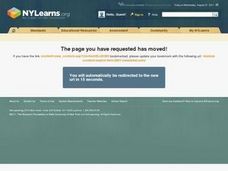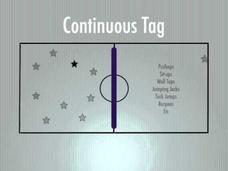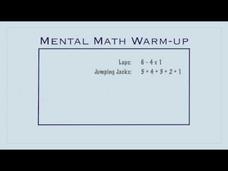Mascil Project
Sports Physiology and Statistics
If I want to build up my heart, where should I start? Science scholars use statistics in a sports physiology setting during an insightful experiment. Groups measure resting and active heart rates and develop a scatter plot that shows the...
Stanford University
A Healthy You
Go beyond counting calories with a healthy eating unit that focuses on reading nutritional labels, making healthy choices, and incorporating fitness into daily life. After four lessons about the different ways kids can improve their...
Curated OER
Fun Fitness Activities For Kids
From shuttle run relays to ACTIVE Bingo, you'll be elated to have this PE resource packet in your tool belt for your next fitness lesson. After all, who wouldn't want to play a game called, "Elephants, Giraffes, and Palm Trees"?
Special Olympics
Train at School
Here is a fantastic compilation of adaptive physical education lesson plans that cover the major concepts of physical fitness, including: aerobic endurance, balance, coordination, flexibility, power, speed and agility, and...
Curated OER
Interdisciplinary Unit On Wellness
Students create a portfolio throughout their middle school years on wellness. Students explore their awareness of the connections between health, physical education, and family and consumer sciences with particular emphasis on the areas...
Nemours KidsHealth
Fast Break!: Grades K-2
Before a test or quiz, warm up the brain and body with two minutes of exercise. Browse seven cards that showcase a different exercise. Each card provides a picture and a written description.
Nemours KidsHealth
Obesity: Grades 9-12
High schoolers take on the role of the nation's first Teen Nutrition and Fitness Czars and create tips that can be texted to other teens to remind them about healthy eating and exercising. Groups read articles to gather background...
Nemours KidsHealth
Obesity: Grades 6-8
Screen time and fast foods, sugary drinks and greasy fries have lead to one-third of tween and teens being overweight or obese. As part of the Health Problems Series scholars analyze the nutritional value of the school food services menu...
Nemours KidsHealth
Fitness: Grades 6-8
Middle schoolers will get a kick out of a lesson that asks them to first design a proposal for a kickboxing routine for Kickin' Kelly's new DVD. A second activity has them explaining the fitness routine they will follow to prepare to be...
Nemours KidsHealth
Fitness: Grades 9-12
Get off the couch, potato! Fitness is the focus of a resource that offers two engaging activities. The first has class members design a 5-day, 60-minute exercise session program for reluctant teens. The second activity asks teams to...
Serendip
Evolution and Adaptations
Survival of the fittest isn't just for the movies! A five-part lesson explores several different species with known adaptations and analyzes them for their survival strategies. Using both video and research data, scholars draw...
US Department of Veterans Affairs
Sample Flexibility Plan for Beginners
Boost flexibility with a set of stretches designed for beginners. Pictures and descriptions guide readers through a variety of stretches while standing, sitting, and lying on the floor.
S&S Worldwide
Fitness Challenge
Don't be a couch potato! Get up and moving with a February 2018 calendar that suggests daily exercises that will get your feet walking and your heart pumping. There's even a special challenge for Super Bowl Sunday.
PhysEdGames
Hospital Tag
Begin the game by setting up the two opposite corners of the gym as hospitals, while assigning two taggers. Choose two people as ambulance drivers, and they will use the scooters as ambulance beds (scooters are connected with a mat on...
PhysEdGames
Continuous Tag
Assign a tagger, and everyone else as runners. The tagger will tag people at random. Persons tagged must go to the other side of the gym court to perform a skill. Once they are done, they can go back in the game.
PhysEdGames
Red-Light Green-Light
Choose a person to be the stoplight. Have everyone else line up on the opposite side of the gym. If "green light" is called out, the players run toward the stoplight person until they hear "red light," which means stop. Anyone that does...
PhysEdGames
Knock'em Downers and Pick'em Uppers
Set up several cones, pylons, or pins around the gym floor. Split that class into two equal groups. Assign one team as the knock'em downers and the other team as the pick'em uppers. Each team does exactly what their name implies....
PhysEdGames
Strikeball
Groups form a circle with each person's feet spread shoulder width apart and touching the person's next to them. Drop a ball in the middle of the circle. The object of the game is for players to keep the ball...
PhysEdGames
Commandos
First create a starting line and ending line in the gym. After divvying up the class into equal teams, each team lines up in a straight row behind the starting point. Each player is lined up behind the other on their team. When...
PhysEdGames
4-Side Warmup
Write four exercises on separate sheets of paper and hang them in the four corners of the gym. Include the name of the exercise and the number of reps for each. Assign class members to each corner. Instruct athletes to...
PhysEdGames
Crows and Cranes
After separating the class into two teams—crows and cranes—each team lines up in the middle line of the gym with their backs facing each other. If the teacher yells out "cranes!" then all the cranes run to their side of the...
PhysEdGames
Pass and Score Tag
Give two taggers a pool noodle and two freers a foam ball. If runners get tagged, then the freers must free them by throwing the ball to them. The trick is freers can't move when they throw, and runners must catch the ball to be free....
PhysEdGames
The Video Camera Game
Implement a fun game at the start of your next physical education class to warm-up the class' bodies. Call out video-editing terms to signal a particular tasks such as walking, running, jumping and more!
PhysEdGames
Mental Math Warm-Up
Use a simple warm-up that has pupils solving math equations to determine the number of reps for a certain exercise. Learners use mental math to solve basic equations. Next, they must do the same number reps of whatever exercise...

























